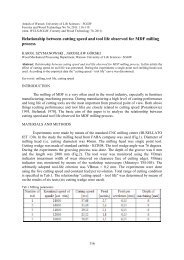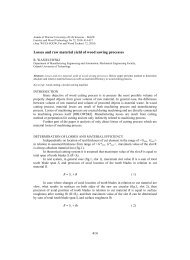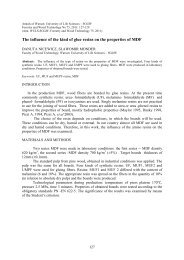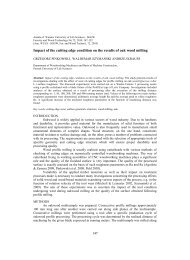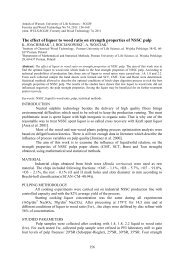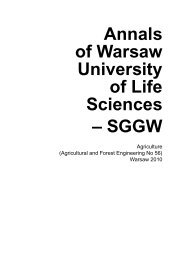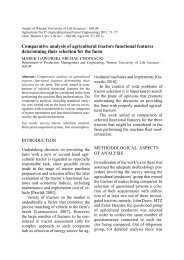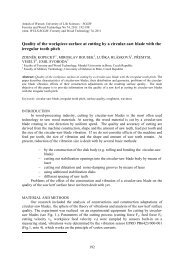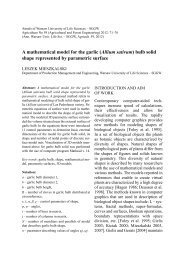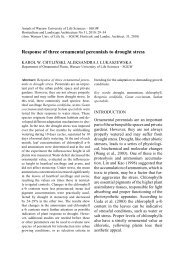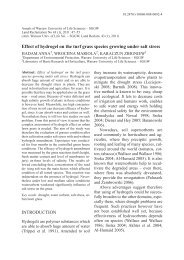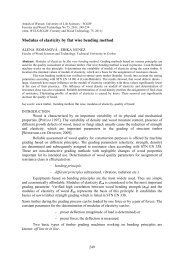Annals of Warsaw University of Life Sciences – SGGW. Animal ...
Annals of Warsaw University of Life Sciences – SGGW. Animal ...
Annals of Warsaw University of Life Sciences – SGGW. Animal ...
Create successful ePaper yourself
Turn your PDF publications into a flip-book with our unique Google optimized e-Paper software.
46 T. Kaleta, A. Szymańska<br />
upon post-USSR republics in which legislation<br />
<strong>of</strong> wildlife trade is <strong>of</strong>ten poorly<br />
enforced. These republics are exporters<br />
and re-exporters <strong>of</strong> many animals and<br />
animal products highly prized in the<br />
West. Therefore, Poland may be seen<br />
also as transit country on the route <strong>of</strong><br />
legal and illicit trade in animals.<br />
Although Poland signed CITES in<br />
1989, the real participation in trade control<br />
based on Convention begun ten years<br />
later (Trusiński, 2009). Thus, the good<br />
starting point <strong>of</strong> any analysis <strong>of</strong> custom<br />
service work concerning transported animals<br />
should be this year.<br />
In this study we concerned ourselves<br />
with the number and type <strong>of</strong> confiscation<br />
<strong>of</strong> live animals executed in Poland<br />
by custom service in concordance with<br />
EU law and CITES. The reason <strong>of</strong> preference<br />
<strong>of</strong> live animals over animal products<br />
is the fact <strong>of</strong> growing popularity <strong>of</strong><br />
pet animals (specially exotic species). It<br />
has been recorded already in 20th century<br />
(Serpell, 1996), and has caused many<br />
problems. For example exotic pet trade<br />
is <strong>of</strong>ten based on taking animals from<br />
the wild which is harmful for nature conservation<br />
(Fitzgerald, 1989). It should<br />
be noted that EU law imposed ban on<br />
the trade in many live animals devoid<br />
<strong>of</strong> proper documentation. For example<br />
this is the case <strong>of</strong> monkeys and apes,<br />
parrots and parakeets, tortoises crocodilians,<br />
some amphibians and invertebrates<br />
(tarantulas, leeches etc) (EU Wildlife<br />
Trade Regulation, 1996).<br />
MATERIAL AND METHOD<br />
The data concerning confiscation <strong>of</strong><br />
individuals from wildlife species in<br />
Poland during the 1998<strong>–</strong>2008 period was<br />
provided by the Department <strong>of</strong> Custom<br />
Service in Polish Ministry <strong>of</strong> Finances.<br />
The reason <strong>of</strong> confiscation was usually<br />
lack <strong>of</strong> special documentation needed<br />
for species covered by CITES and EU<br />
law. This database covered cases <strong>of</strong><br />
confiscations recorded at the frontier<br />
points and at the Custom Office province<br />
headquarters (in Poland custom service<br />
is decentralized). Some data concerned<br />
also confiscation in home market. Place,<br />
date, confiscated species, number <strong>of</strong> individuals,<br />
source country and target country<br />
(in the case <strong>of</strong> transit) were recorded in<br />
each case. Only records with full description<br />
were selected to further analysis.<br />
RESULTS<br />
Table 1 focuses on place where the animals<br />
were confiscated. The confiscations<br />
took place at 16 points. They were located<br />
either at the frontier (e.g. Cieszyn) or at<br />
Custom Office province headquarter<br />
(e.g. Wrocław, Cracow). Some confiscations<br />
also took place in Okęcie Airport<br />
in <strong>Warsaw</strong> and during controls in central<br />
part <strong>of</strong> the country. Confiscated animals<br />
arrived from 19 countries (import), in 8<br />
cases Poland was source country (export)<br />
and in two cases there was transit.<br />
In the studied period Cieszyn and<br />
Przemyśl turned out to be frontier posts<br />
where the greater number <strong>of</strong> smuggling<br />
acts was foiled. This fact is in accordance<br />
with the visible trend <strong>of</strong> direction <strong>of</strong> trade<br />
in animals leading to the Polish territory.<br />
As a whole the greater number <strong>of</strong> confiscations<br />
imported animals was noted<br />
at places geographically connected with<br />
the eastern and southern border (Tab. 1).<br />
In fact, as further analysis showed the<br />
import from Czech Republic accounted



